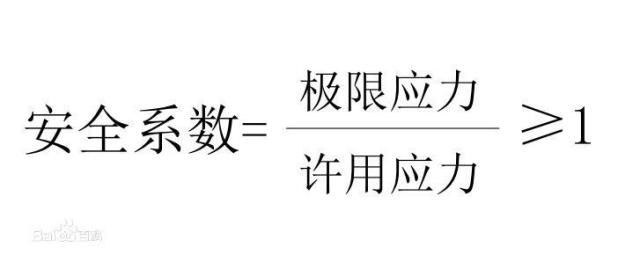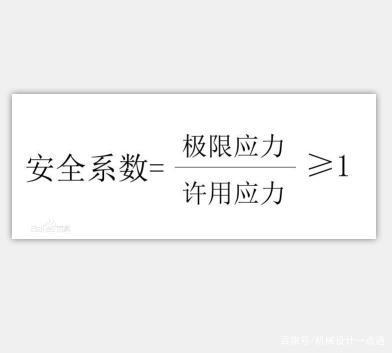ansys 静力结构分析中的安全系数如何计算的,到底是越大越好吗?——通过查看帮助文件,发现安全系数(safety factor)应该是越大越好。


2021r1经常报错,经常退出,什么原因?

安全系数=极限应力/许用应力,极限和许用应力的区别是什么?
机械就这么简单2019-10-30 07:07
点击上方“机械设计一点通”关注我们,做一个爱学习的机械人

安全系数(factor of safety)是工程结构设计方法中用以反映结构安全程度的系数。
安全系数是进行土木、机械等工程设计时,为了防止因材料的缺点、工作的偏差、外力的突增等因素所引起的后果,工程的受力部分理论上能够担负的力必须大于其实际上担负的力,,即极限应力与许用应力之比,二者之比叫做安全系数。
即安全系数=极限应力/许用应力
对于钢丝绳、吊装带等索具的安全系数计算方法,则为:安全系数=最小破断拉力/额定载荷
但是对于上述安全系数中,极限应力与许用应力,最小断裂拉力与额定载荷之间的关系到底是什么呢?
在“安全系数=极限应力/许用应力”中,极限应力指的是材料发生破坏,丧失其功能时的应力值,对于塑性材料,当其达到屈服而发生显著的塑性变形时,即丧失了正常的工作能力,所以通常取屈服极限作为极限应力;对于无明显屈服阶段的塑性材料,则取对应于塑性应变为0.2%时的应力为极限应力。对于脆性材料,由于材料在破坏前都不会产生明显的塑性变形,只有在断裂时才丧失正常工作能力,所以应取强度极限为极限应力。
许用应力=极限应力/安全系数,而安全系数大于1,所以许用应力一定是小于极限应力的,即极限应力是100N的话表示材料发生损坏的极限受力是100N,取安全系数=2的话,许用应力即为50N,所以材料考虑安全系数后的许用应力是50N,即在选用这种材料时,工作载荷不能超过50N;
既然许用应力与安全系数有关系,为什么很多材料查手册时都有给定了许用应力呢?极限应力是试验得出的数据,而许用应力则一般是由国家工程主管部门根据安全和经济的原则,按材料的强度、载荷、环境情况、加工质量、计算精确度和零件或构件的重要性等加以规定。
对于钢丝绳、吊装带等索具的最小破断拉力与额定载荷之间的关系跟上述是类似的,只是对应的额定载荷并不由国家直接规定,而是根据相应行业规范选取相应的安全系数,进行计算许用额定载荷后,与实际计算的工作载荷进行对比,满足使用条件才算合格。

欢迎大家在评论处补充你认为文章中有解释不对或欠缺的部分,这样下一个阅读的人就会学到更多,你知道的正是大家需要的……
更多机械,制造,设计类 干货文章,请关注我们,做一个爱学习的机械人。
RESULTS | 19.5. STRUCTURAL RESULTS | 19.5.10. STRESS TOOLS |
PRINT PAGE
19.5.10.4. Maximum Tensile Stress Safety Tool
The Maximum Tensile Stress Safety tool is based on the maximum tensile stress failure theory for brittle materials.
The theory states that failure occurs when the maximum principal stress equals or exceeds a tensile stress limit. Expressing the theory as a design goal:

The maximum tensile stress failure theory is typically used to predict fracture in brittle materials with static loads. Brittle materials include glass, cast iron, concrete, porcelain and certain hardened steels.
The design goal is to limit the greatest principal stress to be less than the material's ultimate strength in tension:

An alternate definition compares the greatest principal stress to the yield strength of the material:

For many materials (usually ductile materials), strength in compression and in tension are roughly equal. For brittle materials, the compressive strength is usually much greater than the tensile strength.
The Mohr-Coulomb theory used in the Mohr-Coulomb Stress Safety tool is generally regarded as more reliable for a broader range of brittle materials. However, as pointed out by R. C. Juvinall (Engineering Considerations of Stress, Strain, and Strength, McGraw-Hill, 1967), "There is some evidence to support its use with porcelain and concrete. Also, it has been used in the design of guns, as some test results on thick-walled cylinders tend to agree with this theory."
Options
Define the stress limit in the Details under Stress Limit Type. Use either Tensile Yield Per Material, or Tensile Ultimate Per Material, or enter a Custom Value. By default, Stress Limit Type equals Tensile Yield Per Material.
Select one of the following Stress Tool results from the Result group of the Stress Tool tab or by right-clicking and selecting Insert > [result type]:
Safety Factor

Safety Margin

Stress Ratio

Notes
-
The use of a yield strength limit with brittle materials is not recommended since most brittle materials do not exhibit a well-defined yield strength.
-
For ductile and some other types of materials, experiments have shown that brittle failure theories may be inaccurate and unsafe to use. The brittle failure theories may also be inaccurate for certain brittle materials. Potential inaccuracies are of particular concern if the accuracy of calculated answers is suspect.
-
The reliability of this failure criterion is directly related to treatment of stress risers (peak stresses). For brittle homogeneous materials such as glass, stress risers are very important, and it follows that the calculated stresses should have the highest possible accuracy or significant factors of safety should be expected or employed. If the calculated results are suspect, consider the calculated stresses to be nominal stresses, and amplify the nominal stresses by an appropriate stress concentration factor Kt. Values for Kt are available in many strength of materials handbooks. For brittle nonhomogeneous materials such as gray cast iron, stress risers may be of minimal importance.
-
If a part or structure is known or suspected to contain cracks, flaws, or is designed with sharp notches or re-entrant corners, a more advanced analysis may be required to confirm its structural integrity. Such discontinuities are known to produce singular (that is, infinite) elastic stresses: if the possibility exists that the material might behave in a brittle manner, a more rigorous fracture mechanics evaluation must be performed. An analyst skilled in fracture analysis can use the Mechanical APDL application program to determine fracture mechanics information.
-
The proper selection and use of a failure theory relies on your engineering judgment. Refer to engineering texts such as Engineering Considerations of Stress, Strain, and Strength by R. C. Juvinall (McGraw-Hill) and Mechanical Engineering Design by J. E. Shigley (McGraw-Hill) for in-depth discussions on the applied theories.
« 19.5.10.3. MOHR-COULOMB STRESS SAFETY TOOL
19.5.11. FATIGUE (FATIGUE TOOL) »
Contains proprietary and confidential information of ANSYS, Inc. and its subsidiaries and affiliates.
Release 2024 R2 - © ANSYS, Inc. All rights reserved.


























 5748
5748

 被折叠的 条评论
为什么被折叠?
被折叠的 条评论
为什么被折叠?








